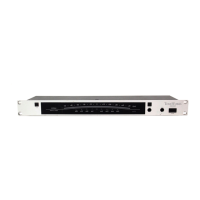FRONT PANEL AND REAR PANEL
1) POWER switch
2) INPUT jack
Jack for connecting the instrument to be tuned.
However when a plug is connected to this jack,
the rear panel INPUT jack (10) cannot be used.
3) MUTE key/jack
Sets mute on/off. When mute is turned on,
sound from the output jack is muted, enabling
tuning without producing sound.
4) MUTE indicator
Lights when mute is set to on (3 MUTE
key/jack).
5) LED meter
Indicates the difference between the reference
pitch and input sound in units of CENTs (within
the range of -50 cents to +50 cents). Adjust the
pitch of the instrument so that the center LED
lights.
6) CALIBRATION scale
Indicates a set reference pitch by a blinking
NOTE LED (7) corresponding to
CALIBRATION scale. For example, if the pitch
is 440 Hz, E of the NOTE LED blinks, and if the
pitch is 441 Hz, F of the NOTE LED blinks. If a
reference pitch set by automatic reference
calibration exceeds the range of 438 Hz – 445
Hz, either C or # of the NOTE LED blinks
dimmer according the excess level.
7) NOTE LED
Indicates the pitch name closest to the input
sound by lighting the LED and # during tuning.
Indicates the set reference pitch with a blinking
LED during calibrating (6 CALIBRATION
scale).
8) CALIB key (Calibration key)
Sets the reference pitch (the center of a piano =
A4) for tuning. There are two ways of setting
the reference pitch; manual calibration and
automatic reference calibration.
9) Rack mount hole
10) INPUT jack
The jack for connecting the instrument to be
tuned. However when a plug is connected to
the INPUT jack (2) on the front panel, this
INPUT jack cannot be used.
11) OUTPUT jack
Connects to the amplifier, mixer, etc. Outputs
the input from the INPUT jack (2 or 10).
12) MUTE jack
Selects mute on/off with the latching type
footswitch connected to this jack. When Mute is
ON, sound from the OUTPUT jack (11) is
muted, enabling silent tuning. Mute lights on
the MUTE indicator (4). However when a
footswitch is connected to the MUTE jack (3)
on the front panel, this MUTE jack cannot be
used.

